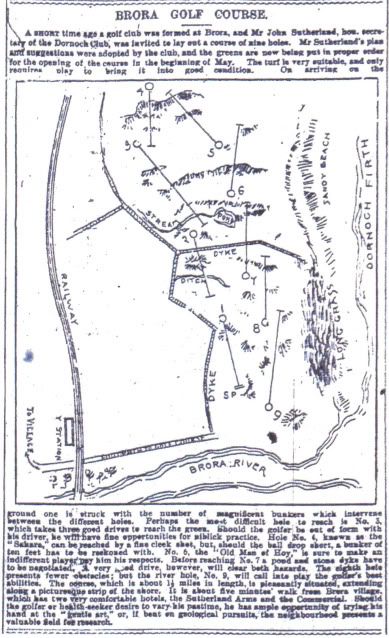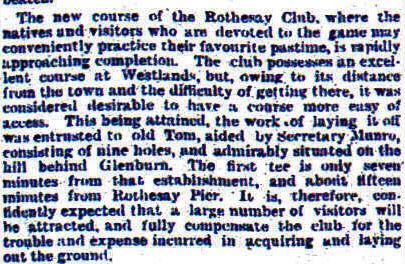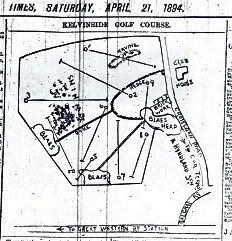Research as we all know is an ongoing thing, in parts itís like a snake, leading you on a merry chase through subject matters that on first inspection gives the impression of a dead end. However, by the very nature one has to follow to the last word on that last page, just in case you miss a simple little clue.
I though I knew a reasonable amount about Old Tom, however when certain comments were made by others questioning his contributions in the field of design /architecture, I though I had to dig deeper. Therefore, about 18 months or so ago, I really started in earnest my search to find out more on Old Tomís design input. I produced my first list of courses with a connection to Old Tom, just under half of that list I sourced from other writers and books, not realising that they had made some errors, which inevitably I reproduced on my list.
The classic being Brora, which according to Malcolm Campbell in his book ĎThe Scottish Golf Bookí, was originally laid out by Old Tom. Subsequently, I found this to be incorrect when I uncovered the Scotsman report of Sutherland involvement not just in the original 9 but the extension a few years later to 18. However, as I said above one has to read to the end of the page, that last word, because during my search I noted reports that golf had been played at Brora pre Sutherlands design, in fact some half a dozen years earlier to the mid 1880ís. I have been advised that there are stories that Old Tom was responsible for an 1880ís course, but all I have found to date are a couple of reports of the game being played pre 1891/2 at Brora and cannot confirm if Old Tom was or was not involved. Nevertheless an interesting point is that Old Tom was in the area at Dornoch designing their modification around that time, so who knows, but no recorded facts confirming either way.

The latest additions to the long list of Old Tomís designs include Strathlene Buckie GC, Dunfermline and Rothesay. Reports also exist of Kingussie commissioning Old Tom, but he was unable to attend at the appointed time. Also of Hall Blyth, recommending Old Tom for the design of Braid Hills to be assisted by P McEwan of Musselburgh, by the time Edinburgh Council agreed to start the work Old Tom was in Northern Ireland leaving it to McEwan and assistant to complete the design. Then letís not forgetting his commission for the North Berwick West Links extension assisted by Strath. I believe that the routing was by Old Tom but the works was actually supervised by Whitecross under the eye of Brodie with Strath responsibility being for the construction team for the Greens. Interesting that they had Old Tom visit prior to the opening to give his opinion on the completed course as well as returning later to be part of the Opening Ceremony.

The list continues with more new finds, including Sir Donald Curryís private 9 hole course at his home near Loch Tay, Kelvinside, Blairlodge School (now moved and known as Polmont GC and Killearn. More courses are currently being checked before being included on my new list, however I must add that I have been greatly helped in my research by Niall Carlton (a fellow Member of GCA.com) who has searched his local newspaper archives in both Glasgow and Elgin.

The picture emerging is that Old Tom was actively involved in designing the golf courses through GB&I. Clubs and the Nobility went to great efforts to seek out his design abilities, however due to pressure of work he was unable to undertake all the designs being asked of him. Then I suppose we should consider that we are talking about a man in his late 60 and early 70ís in a time when the average life span of circa 45 years. Not forgetting that transport in those days was steam train, steam ships then pony and trap. That alone would be a challenge to most of us today not to mention having to survey and designing a course once on site.
The list of courses designed /modified by Old Tom is now close to 100 mark, which does not include the survey only work, Opening of Clubs or attending an opening ceremony let alone using the local facilities.
In between my searches, I am in the process of writing an account on the design approach of the early Victorian Designers, which will clearly show and no doubt once and for all dismiss the idea that a course was designed, AM and ready for play PM. The process took a minimum 8-12 weeks and the AM/PM misunderstanding will be explained, however I still do not understand why the later designers in the early 20th Century seem to have forgotten the process, considering that they were actually following it in just about every detail.
Slowly the history of the early game is being uncovered, originally much was thought lost due to many early clubhouse fires, but we are step by step starting to piece together articles and reports which will help us understanding what actually went on in those great days. We need to know all that when on, not to mention the how and why, yet apparently it was not remembered by the next generation of designers. Surprisingly, I have found no big or dark secrets, just common sense in their approach to their work, which makes me wonder why the likes of Simpson and co never understood many of their predecessors.
We must thank guys like Niall Carlton who are digging away at the grass roots of our early history uncovering many interesting items, one being the actual extent of designs work and how active Old Tom was in the overall design process from 1840ís to 1905.
I hope some of the above information may be of interest to some of you
Melvyn